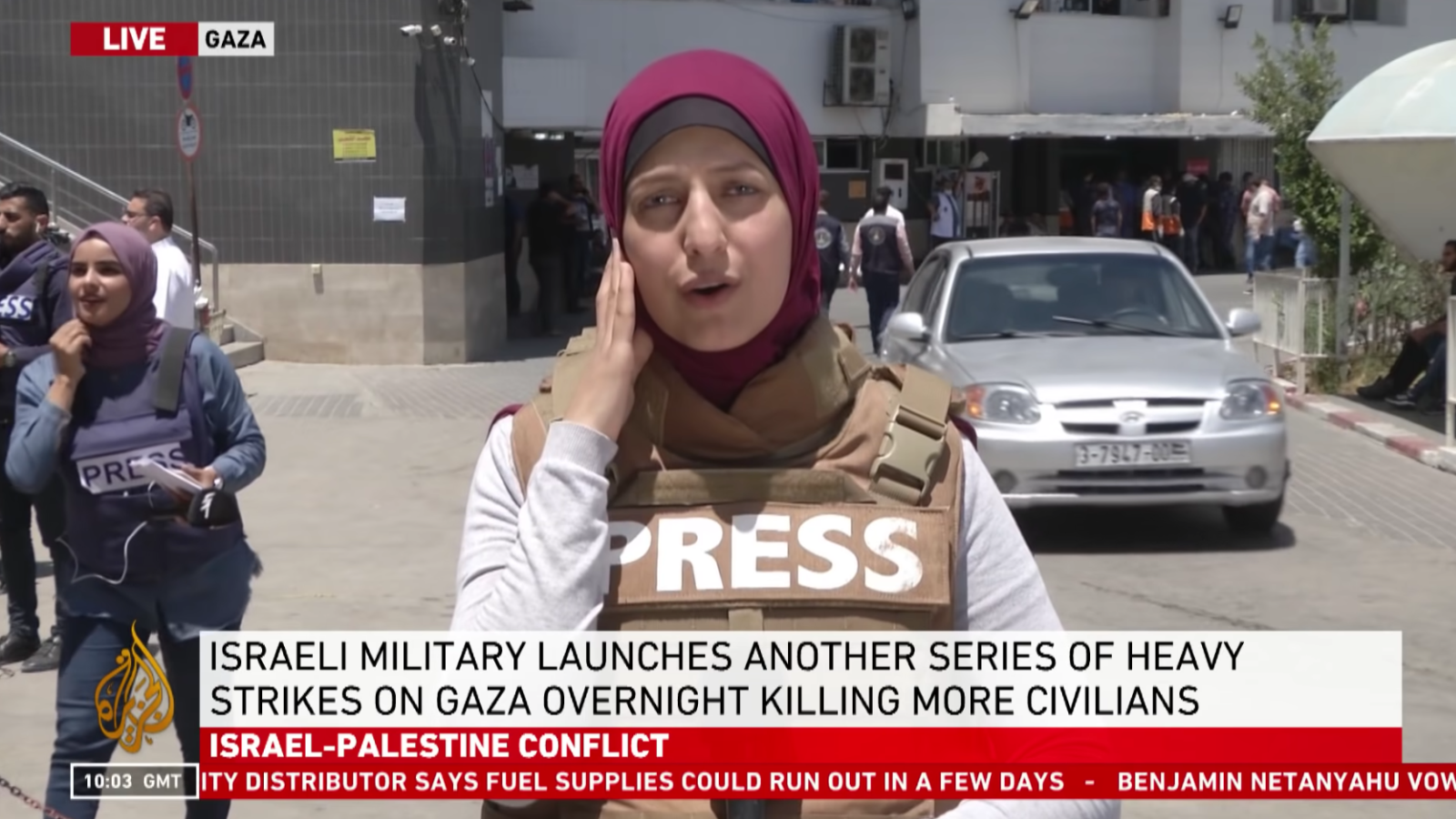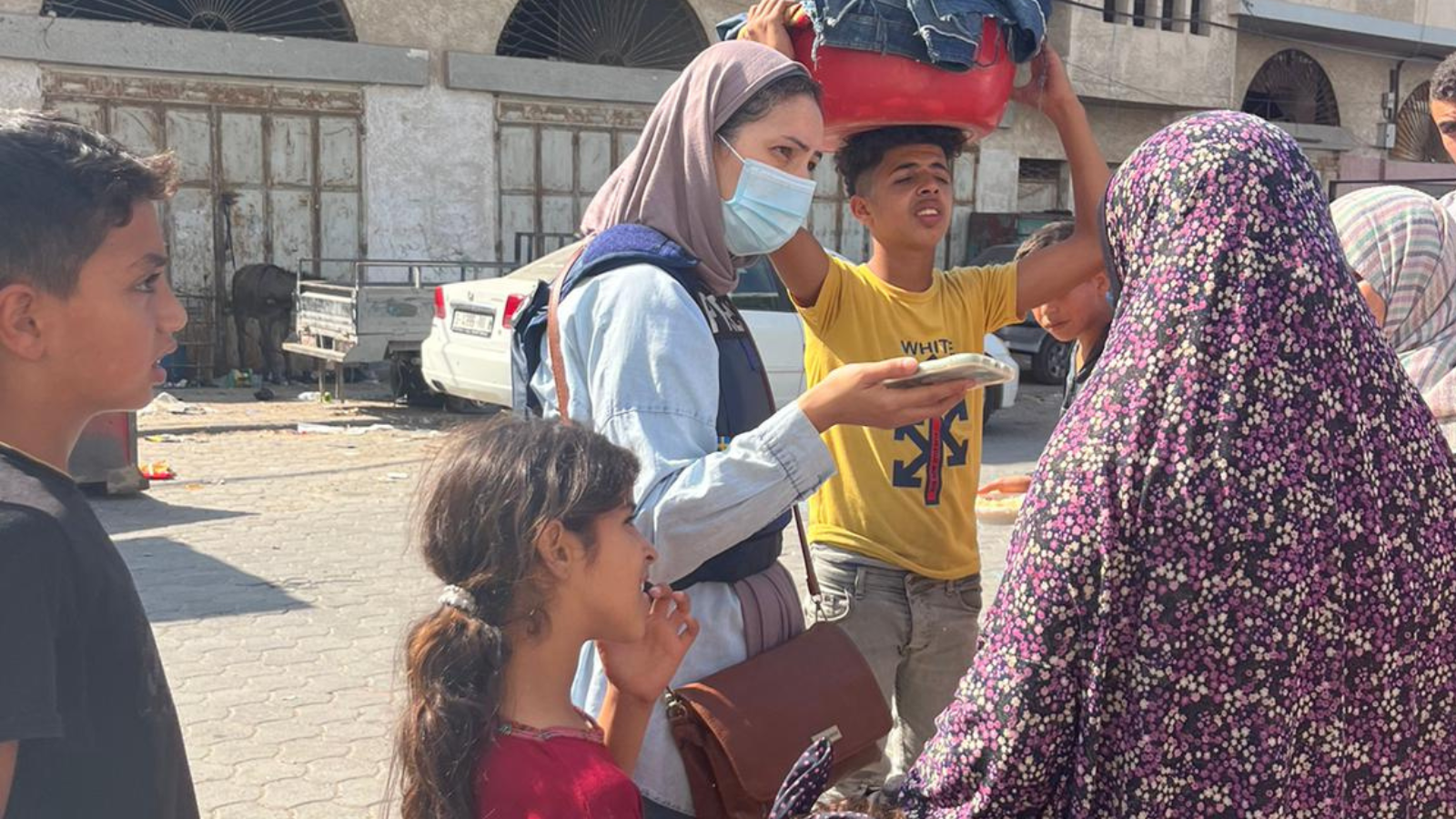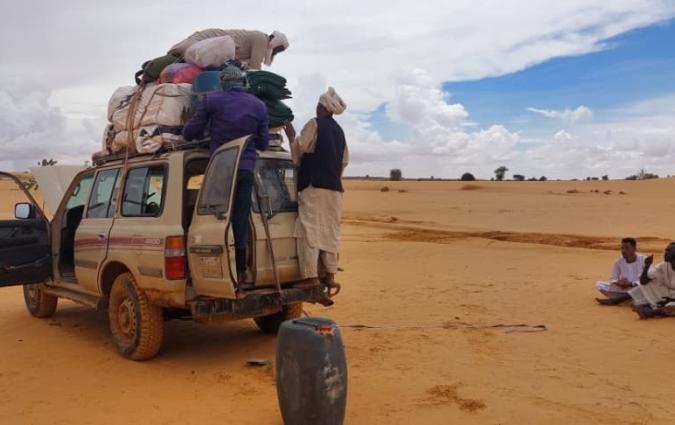These journalists from Gaza risk their lives to cover the Israel-Hamas war: "Nothing can describe what you feel"

Mourners at the funeral of Palestinian journalist Mohammed Abu Hatab. REUTERS/Mohammed Salem
Four days after the family of Al Jazeera journalist Wael Dahdouh were killed in an Israeli airstrike, her colleague Youmna ElSayed’s husband received an anonymous phone call. The voice on the other end told him: “‘You're speaking to the IDF [Israel Defence Forces]. You need to take your family and leave your home right now. Otherwise, your life will be in danger.’”
ElSayed, who works as an Al Jazeera English correspondent, had just changed her SIM card and the army didn’t have her phone number. So she believes her family was being targeted due to her work as a journalist. No other families in her apartment block got the same personal notification; mass evacuation orders usually come in the form of a recorded voice message. ElSayed took this not as a warning but as a threat.
In a war where the official death toll has surpassed 19,000 and where most of the casualties are civilians, journalists have not been spared. The conflict has become one of the most deadly for media workers. According to the Committee to Protect Journalists (CPJ), as of 13 December, at least 63 have been killed, including 56 Palestinians, 4 Israelis and 3 Lebanese. Its President Jodie Ginsberg told me this current war is “unprecedented for the rate in which journalists are being killed” and “is like no other we have seen.”
I spoke with ElSayed and with two other journalists from Gaza about their lack of safety, the threats from the IDF, and the extreme practical challenges and moral dilemmas posed in the course of their reporting. This piece offers an overview of the many challenges Palestinian journalists face when reporting on the Israel-Hamas war while friends and family struggle to meet the basic need for shelter, water and food.
“Nothing protects journalists”
On 2 November Palestine TV reporter Salman al-Bashir removed his flak jacket and helmet as he broadcast live outside Nasser Hospital in the south of Gaza. Al-Bashir was reporting on the death of his colleague Mohammed Abu Hatab, who had been killed alongside 11 members of his family by an airstrike on their Khan Younis home. “These protection jackets and helmets don’t protect us. Nothing protects journalists,” he said to the studio anchor as she wept.
This is a familiar feeling to Nagham Mohanna, an alumna of our Journalist Fellowship and a Gaza-based reporter for UAE-based news outlet The National. Mohanna, who corresponded with me over a series of WhatsApp messages and voice notes due to a patchy connection, thinks that the very equipment that exists to identify journalists in conflict zones serves little purpose in this war.
“If you wear your flak jacket and your helmet, you have the press logo, and you are moving with a car that has the TV logo, even all of that doesn't protect you,” she says. ElSayed goes even further. She believes her protective equipment effectively puts a target on her back: “We got to the point where wearing our press vests seems like putting ourselves in danger. We’re afraid to wear them because we don't want to label ourselves as journalists.”

Journalists in Gaza do not have the ability to cover the war from the sidelines and retreat to relative safety when necessary. They are living in the Strip along with their partners and families and amid what the Financial Times has described as “a devastating bombing campaign.”
“Nothing is safe in Gaza,” Mohanna says. “Even when you are reporting, nothing is safe around you.” On Friday 15 December, Wael Dahdouh and Al Jazeera colleague Samer Abu Daqqa were injured in a drone strike in Khan Younis.
CPJ’s President Ginsberg echoes this sentiment. “We have shared basic safety guidance and continue to push governments to allow personal protective equipment [PPE] to be supplied, but nowhere in Gaza is currently safe and no amount of PPE can protect you from this level of bombardment.”
Following the war from afar
Freelance journalist and filmmaker Yousef Alhelou is from Gaza, but is currently based in London and following the war from afar. He is also an alumnus of our Journalist Fellowship and has covered multiple wars in Gaza before.
Alhelou is in several WhatsApp groups with journalists on the ground and they share with him some of the challenges they are facing right now.
“You don't have a shelter or an office, you face difficulty recharging your phone and you run out of internet data,” he says. “Many journalists don't have these vests or these helmets. Many can’t find food or even drinking water. Toilets are not available and having a shower has become a dream.”
On Wednesday CNN reporter Clarissa Ward became the first foreign reporter to enter Gaza without being embedded with the IDF. She managed to enter the Strip with an Emirati medical team and reported what she saw in one of the hospitals. Ward paid tribute to her Palestinian colleagues, who’ve been covering the war for local and international outlets for the past two months.
Most of the coverage has come from journalists already living in the Strip despite their struggles to carry out basic reporting duties.
“Much of the time I’m looking for an internet connection to send my work,” Mohanna says. “I’m leaving home and look for any place with an internet connection, any coffee shop. It’s not easy for us to work in these circumstances. Sometimes I’m forced to give my reports [to my colleagues] on phone calls.”

Alhelou thinks these circumstances are taking a toll on many of his colleagues in Gaza. “[Journalists'] resilience has been shaken, but at the end of the day we are human beings,” he says. “We are not superheroes. Many journalists are worried and don't sleep enough. They say ‘this is the only thing we can do. We are the eyes of the world. We will continue reporting whatever it takes.’”
Are journalists being targeted?
Though ElSayed has covered previous military operations in the Gaza Strip, she says this war is very different from any other she’s covered. “Everything is being targeted and under fire [and we are seeing] the targeting of journalists,” she says.
Israel denies targeting journalists. But three weeks into the war its government warned Reuters and AFP that it could not guarantee the safety of their reporters in the Strip.
The warning came 10 days after Reuters visual journalist Issam Abdallah was killed by Israeli tank fire on the Lebanese border. Six other reporters were injured in the same incident, including those working for AFP and Al Jazeera, who were clearly identified as journalists when they were hit. Joint investigations by Reuters, AFP, Human Rights Watch and Amnesty International later concluded this was “likely a direct attack on civilians that must be investigated as a war crime.”
In a move which chilled many reporters in Gaza, Benjamin Netanyahu’s office suggested that some Palestinian reporters were “accomplices in crimes against humanity” after a self-styled media watchdog accused several freelance photojournalists working for global news outlets of having prior knowledge of the attacks perpetrated by Hamas on 7 October, in which more than 1,200 people were killed.
Alhelou says that the journalists identified in these reports are now hiding or keeping a very low profile. Several news agencies, including Reuters, stressed that they could not have known of the attack ahead of time. Some of these journalists received death threats after the accusations were published. A few days later, eight members of the family of one of the journalists, Yasser Qudih, were killed by Israeli missiles in their home.
Are journalists being targeted by Israel in Gaza? “Establishing conclusively whether they are deliberately targeted is extremely challenging,” says Ginsberg from CPJ. But she points to the reports that “Israel was responsible for the attack” in Southern Lebanon as something the IDF should answer for.
If journalists have been targeted, Ginsberg says, this would constitute a “war crime” and should be treated as such. She also points out that the IDF killed at least 22 journalists over a 20-year period before 7 October. “No one has been held accountable for any of those deaths,” she says.
Impossible decisions
At the time of my conversation with ElSayed, it was noon in Gaza and her four children had only eaten some biscuits. It was their first meal since 16:00 the previous day.
“My five-year-old is already adapting to that situation,” ElSayed says. “She doesn't even tell me ‘I'm hungry’ because she knows that I have nothing to offer. We've got the money, but there's no food to buy.”
Covering the war while trying to survive under Israel’s bombs means that journalists in Gaza are finding it very difficult to separate professional and personal life.
“This war is very personal for us,” ElSayed says. “We feel it in our homes and in our families. I’m not able to be just a reporter who’s totally focused on her work because I’m also focused on the safety of my family.”
The fear that carrying out reporting duties could risk the wellbeing of their families also weighs heavily on many other Gazan journalists. ElSayed recalls leaving for work one day and becoming separated from her family when bombing cut off one area from another: “Can you imagine me having to be at work, stuck in our bureau, not being able to go home, not being able to even check on my family?”
Mohanna, who’s also a mother, says the situation is very difficult. “It’s not easy for me to leave my home, to say goodbye to my two kids, and to leave them to do my coverage,” she says. “Even the idea that I may not come back for them kills me. If something happened to me, I would be the one responsible.”
Recounting some of the horrific scenes she has witnessed, including “injuries on the floors of the hospitals… blood everywhere… children in dire medical conditions,” ElSayed is conflicted about sharing them with the world.
In a conflict where thousands of children have been killed, she says her hesitancy may stem from the fact that she’s a mother, but she feels she has a professional responsibility too. “I think of it as my job,” she says. “When I'm out there in the field, I have to show the world this. I have to show the world what's happening.”
As she covers the war for Al Jazeera, ElSayed still wonders whether her journalism is having an impact. “After two months, you get to the point where you feel that it's useless,” she says. “You could call it feeling helpless or losing hope.”
According to UN figures, 85% of the people in Gaza have been displaced by the current war. Journalists are not an exception. They have also had to make the fraught decision to relocate to other areas in the Strip.
Mohanna’s house was partially damaged from shelling and she and her family have been forced to relocate twice since the beginning of the war.
ElSayed first moved to the south of Gaza, where basic essentials, including clean drinking water, were so scarce that she risked the treacherous journey back to the north. “I called my manager and I told her, if I'm going to die, I'm going to die from the bombardment,” she says. “I don't want to die of thirst.” ElSayed and her family have been displaced four times in the last two months.
“The story will not end soon”
Speaking from London, filmmaker Alhelou is currently working on a documentary using footage from just a few months ago, before many of the buildings of the Gaza Strip were destroyed.
“We are lucky that we visited Gaza before it was destroyed,” he said. “The footage I have will still remain in our collective memory for generations to come. I'm grateful and sad at the same time that I visited Gaza, which is now destroyed.”
Alhelou knows that Gaza will continue to make headlines for years to come and is determined to be a part of a strong community of journalists reporting from the ground and sharing what they see with the world. “As soon as there is a ceasefire, I'm going to go there,” he says, “because the story will not end soon.”
For now journalists on the ground keep reporting from ruins and hospital wards, hoping the world would pay attention to the destruction around them.
“I often feel paralysed and can't talk about what I'm seeing,” Mohanna says. “I saw a young child crying because he was losing his father, because he saw his father in his last breath. He kept asking me, ‘Where is my father? I want my father to come back.’ How can you deal with this situation? How will you cover something like this? What do you do when you see children who are seven months old and their bodies are all covered with blood?”
Mohanna explains her frustration: “You see these children and you can't comfort them. You can't give them protection and you feel paralysed. These things freeze you and make you feel useless. You can't tell the world what you are seeing. Nothing can describe it. Nothing can really describe what you feel.”






